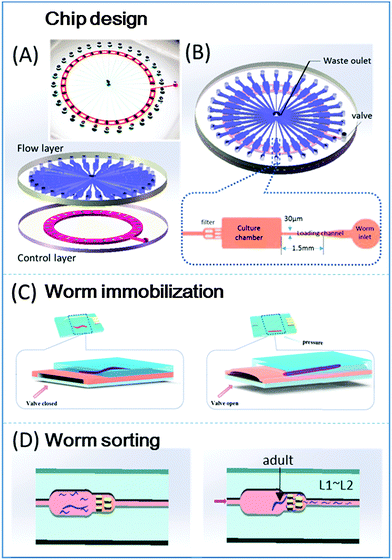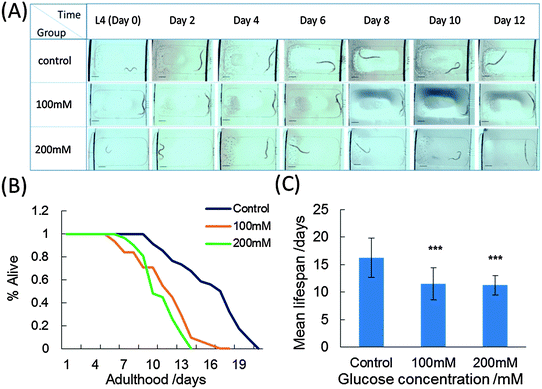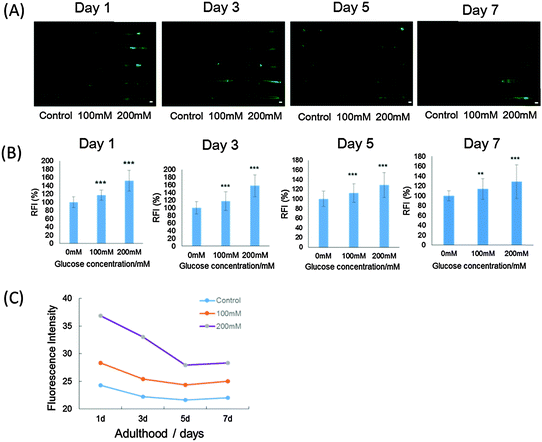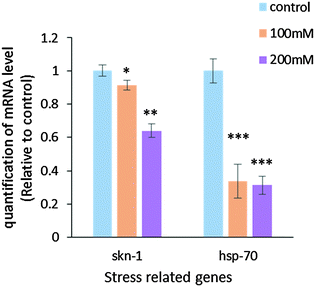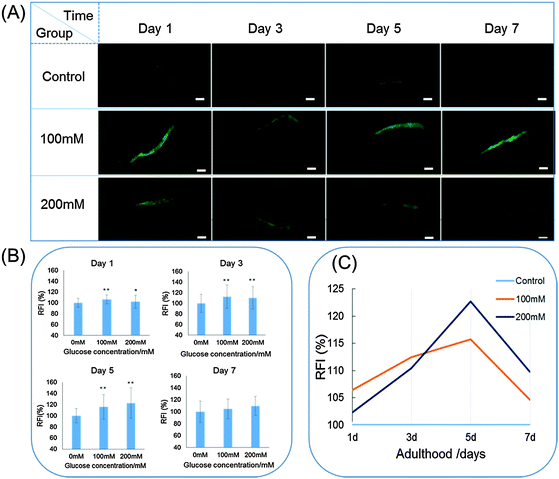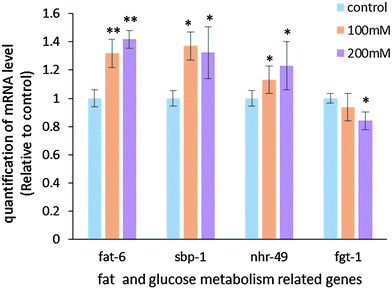Modeling type 2 diabetes-like hyperglycemia in C. elegans on a microdevice†
Guoli
Zhu
,
Fangchao
Yin
,
Li
Wang
,
Wenbo
Wei
,
Lei
Jiang
and
Jianhua
Qin
*
Laboratory of Biotechnology, Dalian Institute of Chemical Physics, Chinese Academy of Sciences, 457 Zhongshan Road, Dalian, 116023, China. E-mail: jhqin@dicp.ac.cn; Fax: +86-411-84379650
First published on 1st December 2015
Abstract
Caenorhabditis elegans (C. elegans) has been widely used as a model organism for biomedical research due to its sufficient homology with mammals at the molecular and genomic levels. In this work, we describe a microfluidic assay to model type 2 diabetes-like hyperglycemia in C. elegans to examine several aspects of this disease on a microdevice. The microdevice is characterized by the integration of long-term worm culture, worm immobilization, and precise chemical stimuli in a single device, thus enabling the multi-parameter analysis of individual worms at a single-animal resolution. With this device, the lifespan, oxidative stress responses, and lipid metabolism of individual worms in response to different glucose concentrations were characterized. It was found that the mean lifespan of worms was significantly reduced by as much as 29.0% and 30.8% in worms that were subjected to 100 mM and 200 mM glucose, respectively. The expression of oxidative stress protein gst-4 was increased, and the expression of hsp-70 (heat shock protein) and skn-1 (redox sensitive transcription factor) genes was down-regulated in worms treated with a high level of glucose. Moreover, fat storage was markedly increased in the bodies of VS29 worms (vha-6p::GFP::dgat-2) that were exposed to the high-glucose condition. The established approach is not only suitable for further elucidation of the mechanism of metabolic disorders involved in diabetes and its complications, but also facilitates the evaluation of anti-diabetic drugs in a high-throughput manner.
Insight, innovation, integrationWe have described an integrated microfluidic device to model type 2 diabetes-like hyperglycemia in C. elegans and examine several aspects of this disease in C. elegans for the first time. The high-glucose condition was found to significantly shorten the lifespan of C. elegans with increased oxidative stress and lipid formation in transgenic C. elegans. These findings highlight the possible contribution of C. elegans to our understanding of diabetes in higher organisms. Moreover, this device is capable of flexible operation with individual worms and with multiple functions and can be easily applied for the study of diabetic complications and testing of medications to treat metabolic disorders. |
Introduction
Caenorhabditis elegans (C. elegans) is an invaluable model organism for biomedical research because it can be used to recapitulate many aspects of human diseases at either the molecular or genomic level in vivo.1,2 As the first animal whose genome was completely sequenced, C. elegans is more than 40% homologous to human genes that have been implicated in many human diseases. C. elegans is a small free-living soil nematode that is characterized by several unique features, such as its small size, short lifespan (2 to 3 weeks), ease of propagation, and optically transparent body. Significant progress has been made in the delineation of genetic and biochemical pathways involved in human disorders with this model organism and in the identification of effective strategies for therapeutic intervention in humans.3–6 In particular, this organism contains many key components related to metabolism, oxidative stress network, and insulin-signaling pathway, making it a useful system to improve our understanding of complex diseases such as diabetes.7,8Diabetes mellitus is a metabolic disorder that affects millions of people worldwide and contributes considerably to the global mortality rate.9 It is characterized by poor control of glucose homeostasis. Glucose, as a major energy source and key regulator of metabolism, induces pancreatic β-cells to secrete insulin, which in turn facilitates the transport of glucose to tissues such as muscle and adipose.10 However, a chronic overabundance of glucose or fructose will have deleterious effects on cellular and tissue functions and has been linked to several disorders including type 2 diabetes, obesity, and cardiac dysfunction.11–13 Schlotterer et al. reported that high glucose may shorten the lifespan of worms,7 and the reduced lifespan was obtained by downregulating DAF-16/FOXO activity and aquaporin gene expression.8 Recent studies have shown that glucose increased fat accumulation in mammals and in worms14,15 and may affect the stress response.10,13,16,17 Diverse studies have demonstrated that oxidative stress participates in the progression of diabetes complications.18 Genes like skn-1 and hsp-70 were found to be the protective genes against oxidative stress.19–23 Moreover, sbp-1, nhr-49, fat-6 and fgt-1 were the genes homologous to mammalian genes which regulated the fat and glucose metabolism.24–28 Although many advances have been made in our understanding of the pathophysiology of diabetes mellitus, its prevalence continues to increase, due in part to changes in lifestyle, increased overall life expectancy, and the complex regulation mechanism that underlies the pathologic process.
In the past few years, microfluidics technology has provided an attractive platform for the study of C. elegans due to its perfect dimension with the size of worms, flexible operation of precise stimuli, seamless integration of active control elements, and its capability for potential high-throughput analysis. Several channel-based and droplet-based microfluidic devices have been developed for various worm manipulations, including worm culture, immobilization, microsurgery, and neural imaging.29–37 They have also been applied to exploit C. elegans as a suitable model for the study of neurobiology, development, Parkinson's disease, aging and behaviour.34,36,38–42 However, no work has been devoted to the study of metabolic disorders relevant to diabetes in C. elegans on the microfluidic device.
In this study, we propose an integrated microfluidic device to resemble the hyperglycemic condition in diabetics using C. elegans as a model. We investigated the various responses of C. elegans exposed to a continuously high glucose concentration in a physiologically relevant manner. The microfluidic device exhibits multiple functions by integrating long-term worm culture with individual worm manipulations in a high-throughput format at a single-animal resolution. We characterized the lifespan, oxidative stress, and lipid formation of C. elegans under a continuous high-glucose condition on the microdevice. We also evaluated the mRNA expression of genes associated with oxidative stress and glucose and fat metabolism. The worms exhibited a shortened lifespan and increased oxidative stress and lipid formation after exposure to a high glucose concentration, indicating their relevance to the pathological changes that appear in patients with diabetes. These results demonstrate the utility of this microfluidic device for multi-parameter analysis of metabolic disorders in C. elegans, thus facilitating the exploration of the mechanism of metabolic disorders and effective evaluation of pharmaceutical compounds for the treatment of diabetes or its complications.
Experimental
1. Fabrication of the microfluidic device
As shown in Fig. 1, the design of the microfluidic device is based on our previous work with major modifications.38 It mainly consists of a microfluidic network including a top worm culture layer and a bottom control layer. This device was fabricated using multilayer soft lithography and rapid prototyping techniques.43–46 Briefly, Si wafers were patterned with SU-8 3035 photoresist (Microchem Corp, Newton, MA) and subjected to the photolithographic processes to achieve a mold with particular dimensions. To fabricate the culture chamber, polydimethylsiloxane (PDMS; Sylgard silicone elastomer 184, Dow Corning Corp., Midland, MI) at a 12![[thin space (1/6-em)]](https://www.rsc.org/images/entities/char_2009.gif) :
:![[thin space (1/6-em)]](https://www.rsc.org/images/entities/char_2009.gif) 1 base-to-curing agent weight ratio was cast onto the flow layer wafer followed by degassing and curing at 80 °C for 1 h. As for the control layer, after patterning, the masters were silanized by exposure to tridecafluoro-1,1,2,2-tetrahydrooctyl trichlorosilane vapor (Sigma Chemical) and positioned in Petri dishes43,47 to prevent the PDMS from adhering to the master. Then, 12
1 base-to-curing agent weight ratio was cast onto the flow layer wafer followed by degassing and curing at 80 °C for 1 h. As for the control layer, after patterning, the masters were silanized by exposure to tridecafluoro-1,1,2,2-tetrahydrooctyl trichlorosilane vapor (Sigma Chemical) and positioned in Petri dishes43,47 to prevent the PDMS from adhering to the master. Then, 12![[thin space (1/6-em)]](https://www.rsc.org/images/entities/char_2009.gif) :
:![[thin space (1/6-em)]](https://www.rsc.org/images/entities/char_2009.gif) 1 ratio PDMS was spun on the master, degassed under a vacuum, and cured (80 °C; 1 h) to achieve a 40 μm-thick membrane higher than the structure that is used to avoid the adhesion of PDMS and the substructure. The flow layer was peeled off the silicon wafer and bonded onto the control layer by plasma bonding. The assembly was gently peeled from the master and trimmed to size, and holes were punched (2 mm diameter). Finally, all devices were bonded onto a glass slide by plasma bonding.
1 ratio PDMS was spun on the master, degassed under a vacuum, and cured (80 °C; 1 h) to achieve a 40 μm-thick membrane higher than the structure that is used to avoid the adhesion of PDMS and the substructure. The flow layer was peeled off the silicon wafer and bonded onto the control layer by plasma bonding. The assembly was gently peeled from the master and trimmed to size, and holes were punched (2 mm diameter). Finally, all devices were bonded onto a glass slide by plasma bonding.
The dimension of the microfluidic network was designed to meet the requirement of continuous worm analysis. In the top layer, the worm loading channel was gradually narrowed from 250 μm to 30 μm and lengthened to 1.5 mm. The dimension of the culture chamber is 2 mm long, 1.2 mm wide, and 65 μm tall, which is suitable for worm culturing and immobilization in the control layer. This design of micropillar structure is used for sorting L1–L2 worms to guarantee a single adult worm in the microchamber. The 30 filter channels are all linked to the central waste reservoir through a 20 μm-wide channel.
2. Worm culture and strains
C. elegans wild-type N2 and all transgenic strains in this study were obtained from the Caenorhabditis Genetics Center at the University of Minnesota-St. Paul. The transgenic strain CL2166 (gst-4::GFP) containing gst-4 reporter was used to illustrate the inducible oxidative stress in the worms. The VS29 strain (vha-6p::GFP::dgat-2) was used to represent the expression quantity of lipid in the worms.All strains were cultured as described by Brenner.3 Briefly, the worms were cultured at 20 °C on standard nematode growth medium agar seeded with Escherichia coli OP50. Before seeding, the bacteria were incubated overnight at 37 °C and stored at 4 °C.
3. Worm synchronization
To synchronize the growth stage of the nematodes, adult worms were treated with NaClO solution 5 M NaOH/NaClO/H2O (1![[thin space (1/6-em)]](https://www.rsc.org/images/entities/char_2009.gif) :
:![[thin space (1/6-em)]](https://www.rsc.org/images/entities/char_2009.gif) 2
2![[thin space (1/6-em)]](https://www.rsc.org/images/entities/char_2009.gif) :
:![[thin space (1/6-em)]](https://www.rsc.org/images/entities/char_2009.gif) 7) at room temperature until the skin of each individual was mostly destroyed.39 The eggs were collected and cultured overnight on fresh nematode growth medium agar plates at 20 °C until hatching.
7) at room temperature until the skin of each individual was mostly destroyed.39 The eggs were collected and cultured overnight on fresh nematode growth medium agar plates at 20 °C until hatching.
4. Glucose assays in worms
Different concentrations (0 mM, 100 mM and 200 mM) of glucose solution were obtained by diluting 40% D(+)-glucose (Sigma) with K medium (50 mM NaCl, 30 mM KCl, 10 mM NaOAc, pH 5.5). Age-synchronous wild-type N2 worms were hatched at the L1 stage and then transferred to microtiter plates and treated with a prepared glucose solution from the L1 stage; the medium was exchanged every day during the worms' lifetime. The worms were kept for 7 days under various glucose concentrations in the microtiter plates prepared as described above, harvested, and washed. An extract of worms was prepared by sonication and analyzed for glucose concentration using a glucose assay kit (Bioassay System).5. Lifespan assays in worms
The microfluidic device was fabricated as described above, and the lifespan assays were performed at 20 °C. The hatched worms (L1 stage) were transferred to K medium in microtiter plates for treatment with glucose. The concentration of glucose was either 100 mM or 200 mM. The worms were then cultured at 20 °C with E. coli strain OP50 as a food source until they reached the L4 stage. The L4 worms were loaded into the microfluidic device. After the worms stabilized in the chambers, we treated them with food OP50 and glucose solution by exchanging the medium twice each day. Worms that did not move after repeated stimulus were regarded as dead. The lifespan assay was performed with a charge-coupled device mounted on a stereozoom microscope (Leica S8APO, Germany). After the L4 worms were loaded into the chip, their survival activity was monitored daily.6. Fluorescent microscopy
The green fluorescence of CL2166 and VS29 worms was examined using an inverted fluorescent microscope (Olympus IX 71, Japan). The excitation and detection wavelengths were set at 470 to 495 nm and 510 to 550 nm, respectively. The fluorescence images were analyzed with image processing and analysis software (IMAGE-PRO, Media Cybernetics, USA) to determine their mean fluorescence density.7. Quantitative real-time polymerase chain reaction
The mRNA expression of oxidative stress associated genes and lipid metabolism genes was assessed by means of a real-time quantitative polymerase chain reaction (PCR) system (Piko Real 2.1) using SYBR green (Takara) as the detection method. The L1 worms were treated with various concentrations of glucose for 72 h and grown until they reached the adult stage. The total RNA was then extracted from the adult worms according to the Trizol treatment procedure. cDNA was produced by oligo (dT) priming (Takara). PCR (95 °C for 30 s; 40 cycles of 95 °C for 5 s, 57 °C for 30 s, 72 °C for 30 s; 60 °C to 95 °C melt curve) was performed using each primer (Table 1). act-1 was used as the internal control.| Primer name | Sequence (from 5′ to 3′) |
|---|---|
| act-1-f | GTCATGGTCGGTATGGGACA |
| act-1-r | AGTGAGGAGGACTGGGTGCT |
| fgt-1-f | GCATTCTCCGCATTTGTCAT |
| fgt-1-r | GGAAAGACCTCCAATCATACCAC |
| nhr-49-f | GATTCGTGATGCTAGAAATCGTGT |
| nhr-49-r | ATCTTGTGGGTGCGTCATCT |
| sbp-1-f | AAGCAGTTGAGATTTGGGTC |
| sbp-1-r | GACGGTCATTGTCATTTAGGAT |
| fat-6-f | AAGGAACAAGGAGCCAAGC |
| fat-6-r | GGAAGAATGAAGCAGCACA |
| skn-1-f | AGTGTCGGCGTTCCAGAT |
| skn-1-r | AAGTGCGGGCAGCAACCT |
| hsp-70-f | AGAAGACGCAGCACAACG |
| hsp-70-r | TTCCATCCAACGAAGGGT |
8. Statistical analysis
Statistical analysis was performed by applying a two-tailed Student's t-test to compare the high-glucose treated group and the non-treated group. The software Excel was used in this work.Results
1. Design and operation of the microdevice
To explore the various effects of high glucose concentrations on C. elegans in a controllable manner, we used a microfluidic device made of an optically transparent PDMS silicone elastomer that contains a flow layer and a control layer, as shown in Fig. 1A. The top layer includes 30 microchambers connected to the microchannel network for loading, culturing, and sorting of individual worms (Fig. 1B). The bottom layer is designed for immobilization of single worms via valve control for imaging analysis (Fig. 1C). The width of the loading channels was gradually reduced to facilitate the loading of individual worms into the culture microchamber for subsequent analysis. The micropillar structure connected to the microchamber is designed to filter out the tiny young L1 and L2 worms, while maintaining a single adult worm within each chamber during the loading and long-term culture process (Fig. 1D).Before the worm assays, single worms were loaded into the culture microchamber by pressure-driven flow via a central waste outlet. Once loaded, the worms were confined to the microchamber surrounded by long inlet channels and micropillars. To achieve long-term worm culture, the worms were infused with sufficient oxygen and food from the worm inlet to the culture chamber twice daily, while maintaining continuous expulsion of metabolites. Glucose was added by mixing it with the food solution and injecting it into the individual loading channels to maintain worm growth under the same glucose concentrations. To perform imaging analyses, the individual worms were immobilized by deforming the membrane of the bottom layer using the microvalve control. The integrated microfluidic device enables worm loading, long-term culture with chemical stimuli, and immobilization with imaging analysis in parallel in a controllable manner, thus facilitating the multi-parameter analysis and real-time tracking of worms under different glucose conditions at single-animal resolution.
2. Dietary glucose triggered different responses in C. elegans
In this study, the intracellular glucose concentrations in worms were determined from whole-body extracts after culturing for 7 days under various glucose concentrations. Under glucose concentrations of 100 mM and 200 mM, the intracellular glucose concentrations from the body extracts of worms were measured at 6.7 mM and 12 mM, respectively, using a glucose assay kit. Because the measured value corresponds to the blood glucose range observed in patients with poorly controlled diabetes, we further characterized the effects of hyperglycemia on the lifespan, stress responses, and fat metabolism of C. elegans in the following experiment.As shown in Fig. 3A, we observed weak GFP expression in the gst-4::GFP worms under normal culture conditions. However, the inducible oxidative protein expression was increased significantly in the bodies of the gst-4::GFP worms after acute exposure to glucose. From the results in Fig. 3B, the protein expression level was significantly higher in the glucose-treated groups than in the control group. Moreover, the protein expression level was higher in the worms treated with 200 mM glucose than in those treated with 100 mM glucose, suggesting a dose-dependent response. Furthermore, the trend in gst-4 protein expression in worms under various glucose concentrations over 7 days is shown in Fig. 3C. It was noted that the expression of gst-4 in the individual worms began to decrease at day 1 after glucose treatment; it continued to decrease at day 5 and became stable at day 7 in both treated and non-treated groups, indicating that the body's resistance to oxidative stress declined gradually as the body aged. Taken together, the data from these studies suggest that gst-4 may be involved in the hermetic response to glucose and contributes to the worms' response to glucose exposure.
We further investigated the expression of the hsp-70 and skn-1 genes in wild-type N2 worms subjected to high glucose levels. As shown in Fig. 4, we observed less mRNA expression of hsp-70 in glucose-treated worms than in untreated worms by quantitative real-time PCR analysis. The down-regulation of hsp-70 suggests that it may be damaged under cellular stress caused by hyperglycemia. The mRNA expression of the skn-1 gene was also down-regulated in worms subjected to a high glucose concentration compared to those in the normal culture condition, indicating the potential role of skn-1 in protecting tissues against oxidative stress in high concentrations of glucose.
From the quantitative real-time PCR analysis shown in Fig. 6, the mRNA expression was remarkably increased in fat metabolism genes sbp-1, nhr-49, and fat-6. The sbp-1 mRNA levels increased markedly, especially in the presence of glucose. The expression of glucose metabolism-related gene fgt-1 was significantly reduced in worms subjected to high glucose conditions for 72 h. These observations suggest that fat levels increase with the intake of excess calories from glucose in C. elegans just as they do in mammals. The profound increase of sbp-1 and nhr-49 at the mRNA level indicated that high glucose intake facilitated fat storage in the intestines of the worms. The transport of glucose from the intestinal cells of worms after high-glucose intake may be disturbed by down-regulation of fgt-1.
Discussion
The main purpose of this study was to establish C. elegans as a model of type 2 diabetes for the study of metabolic disorders on a microdevice and facilitate our understanding of the possible mechanism that underlies the effects of glucose on lifespan, oxidative stress, and glucose/lipid metabolism in diabetes research. We characterized the lifespan, oxidative stress, and lipid storage of C. elegans under continuous high-glucose conditions on the microdevice. We found that long-lasting high-glucose conditions result in a significant reduction in lifespan, an increase in the oxidative stress level, and the accumulation of lipid storage in worms, reflecting the relevant pathological changes that appear in patients with diabetes. Because the total body glucose concentrations of 6.7 mM and 12 mM were sufficient to achieve significant effects on lifespan, oxidative stress, and fat storage, this in vivo model organism in the microdevice provides a potential platform with which to decipher the changes in lifespan, cellular functions, and glucose and fat metabolism disorders triggered by excess glucose intake that are within the range observed in patients with poorly controlled diabetes.Several studies have addressed the effects of dietary glucose on obesity and diabetes, but little is known about its effect on the lifespan itself. We found that a diet of glucose shortened the lifespan of C. elegans by approximately 29.0% and 30.8% at the two different concentrations. Because aging is the most important risk factor for many diseases, including diabetes and cancer, the discovery of effective modulators of lifespan in model organisms could promote new strategies for the treatment of diabetes and other aging-related diseases. In this work, the high-glucose condition was observed to promote the increased expression of oxidative stress protein in transgenic CL2166 (gst-4::GFP) strains. It also down-regulated the expression of the stress-associated skn-1 and hsp-70 genes at the mRNA level in wild-type N2 worms. These data are consistent with our previous findings that the lifespan of worms is closely associated with the oxidative stress induced by external stimuli.39
In mammals, several phase II enzymes, like GST, are regulated by the bZIP transcription factor Nrf2 in response to oxidative or electrophilic stresses.51 In C. elegans, the transcription factor SKN-1 is found to have a function similar to that of Nrf2 by inducing GST-4 expression in response to oxidative stresses. It has been reported that skn-1 may protect neighboring tissues from damage from oxidative stress21 and that skn-1 mutants are sensitive to oxidative stress and have shortened lifespans.22 The hsp-70 genes and humans have a high degree of homology and share a conserved core “adenosine triphosphatase” structure52 and it is associated with cellular stress and may protect against obesity-associated insulin resistance.23 Therefore, we assume that oxidative stress triggered by high levels of glucose may contribute to the shortened lifespan in worms and that this effect might be associated with the regulatory role of the skn-1 gene. This also supports the notion that oxidative stress might cause a reduction in cellular adenosine triphosphate levels, thus leading to the continued prevention of the aggregation of damaged proteins.53
Diabetes is characterized by some critical features, including glucose and lipid metabolism disorders. Several genes have been revealed to regulate the glucose and lipid metabolism in vivo. It has been reported that sbp-1, as a homolog of the mammalian transcription factor SREBP-1c, can facilitate fat storage in mammals.24 In addition, nhr-49, similar to the mammalian PPARs,25 can modulate fat consumption and composition.26 fat-6, encoding delta-9 desaturase for the synthesis of unsaturated fatty acids, was expressed in the intestine27 and indicated fat storage. In contrast, the function of fgt-1, the homologue gene of glut-2 in mammals, facilitated the release of glucose from intestinal cells to the interstitial fluid.28 Research into how hyperglycemia affects the glucose and fat metabolism in C. elegans at the gene level seems important.
In this study, the high-glucose condition was found to promote fat accumulation in the transgenic worm VS29 (hjSi56 vha-6p::GFP::dgat-2), with the up-regulated expression of fat metabolism genes (sbp-1, nhr-49, and fat-6) and down-regulated expression of glucose metabolism gene fgt-1. The profound increase in sbp-1, fat-6, and nhr-49 at the mRNA level indicated that high levels of glucose facilitated fat storage in worms as they do in mammals. It was also noted that the transport and consumption of glucose from intestinal cells may be disturbed after high-glucose treatment by down-regulation of fgt-1. Taken together, examination of the sbp-1, nhr-49, fat-6, and fgt-1 genes is expected to elucidate their regulatory role and contribution to the treatment of diabetes, especially for patients with obesity. It is assumed that long term high-glucose conditions would promote the expression of oxidative stress protein GST-4 and disrupt the glucose transporter gene, which might be responsible for the fat storage and reduction in lifespan seen in worms. It is known that the insulin/insulin-like growth factor 1 signaling pathway plays key roles in aging, development, dauer formation, and storage of macronutrients in granules.54–58C. elegans shares the homology of the insulin/insulin-like growth factor 1 signaling pathway with humans; therefore, further studies to decipher the activation of this insulin/insulin-like growth factor 1 signaling pathway in regulating the lifespan reduction of worms subjected to excess glucose intake are needed.
Conclusions
In summary, we present the worms-on-chip to resemble a diabetes-like model in vitro and to characterize multiple features of worms in response to high-glucose conditions. Hyperglycemia was found to shorten lifespan and increase oxidative stress and fat storage. The highly conserved nature of metabolism and genetics between worms and humans suggests that findings from C. elegans may contribute greatly to our understanding of diabetes in higher organisms. This device is capable of flexible operation with multiple functions, which not only supports the long-term single-worm culture with sufficient nutrient exchange, but also facilitates chemical stimuli and multi-parameter assay in a controllable and parallel manner, thus providing a new platform for the study of diabetes and drug testing in complications of diabetes and metabolic disorders.Acknowledgements
This research was supported by Key Laboratory of Separation Science for Analytical Chemistry (Dalian Institute of Chemical Physics, Chinese Academy of Sciences), International Science & Technology Cooperation Program of China (2015DFA00740), National Nature Science Foundation of China (No. 81273483, 81201689).References
- P. S. Albert and D. L. Riddle, Dev. Biol., 1988, 126, 270–293 CrossRef CAS.
- S. Hashmi, Y. Wang, R. S. Parhar, K. S. Collison, W. Conca, F. Al-Mohanna and R. Gaugler, Nutr. Metab., 2013, 10, 31–41 CAS.
- S. Brenner, Genetics of Caenorhabditis-Elegans, Genetics, 1974, 77, 71–94 CAS.
- J. R. Vanfleteren and B. P. Braeckman, Neurobiol. Aging, 1999, 20, 487–502 CrossRef CAS PubMed.
- J. J. Collins, K. Evason and K. Kornfeld, Exp. Gerontol., 2006, 41, 1032–1039 CrossRef CAS PubMed.
- C. D. Link, Exp. Gerontol., 2006, 41, 1007–1013 CrossRef CAS PubMed.
- A. Schlotterer, G. Kukudov, F. Bozorgmehr, H. Hutter, X. L. Du, D. Oikonomou, Y. Ibrahim, F. Pfisterer, N. Rabbani, P. Thornalley, A. Sayed, T. Fleming, P. Humpert, V. Schwenger, M. Zeier, A. Hamann, D. Stern, M. Brownlee, A. Bierhaus, P. Nawroth and M. Morcos, Diabetes, 2009, 58, 2450–2456 CrossRef CAS PubMed.
- S. J. Lee, C. T. Murphy and C. Kenyon, Cell Metab., 2009, 10, 379–391 CrossRef CAS PubMed.
- M. Kumar, S. Nath, H. K. Prasad, G. D. Sharma and Y. Li, Protein Cell, 2012, 3, 726–738 CrossRef CAS PubMed.
- A. M. Garcia, M. L. Ladage, D. R. Dumesnil, K. Zaman, V. Shulaev, R. K. Azad and P. A. Padilla, Genetics, 2015, 200, 167–184 CrossRef CAS PubMed.
- M. Brownlee, Nature, 2001, 414, 813–820 CrossRef CAS PubMed.
- S. Nowaczewski, K. Stuper, T. Szablewski and H. Kontecka, Poult. Sci., 2011, 90, 2467–2470 CrossRef CAS PubMed.
- A. Tauffenberger and J. A. Parker, PLoS Genet., 2014, 10(5), e1004346 Search PubMed.
- J. M. Olsen, M. Sato, O. S. Dallner, A. L. Sandstrom, D. F. Pisani, J. C. Chambard, E. Z. Amri, D. S. Hutchinson and T. Bengtsson, J. Cell Biol., 2014, 207, 365–374 CAS.
- J. Zheng and F. L. Greenway, Int. J. Obes., 2012, 36, 186–194 CrossRef CAS.
- T. J. Schulz, K. Zarse, A. Voigt, N. Urban, M. Birringer and M. Ristow, Cell Metab., 2007, 6, 280–293 CrossRef CAS.
- S. Schmeisser, K. Zarse and M. Ristow, Horm. Metab. Res., 2011, 43, 687–692 CrossRef CAS.
- E. Wright, J. L. Scism-Bacon and L. C. Glass, Int. J. Clin. Pract., 2006, 60, 308–314 CrossRef CAS.
- G. P. Sykiotis and D. Bohmann, Sci. Signaling, 2010, 3, re3 CrossRef.
- C. M. Felipe, A. N. Juliana, W. W. Hauswirth, R. Linden, P. S. Hilda and L. B. Chiarini, Front. Cell. Neurosci., 2015, 8, 438 Search PubMed.
- T. A. Staab, T. C. Griffen, C. Corcoran, O. Evgrafov, J. A. Knowles and D. Sieburth, PLoS Genet., 2013, 9(3), e1003354 CAS.
- J. H. An and T. K. Blackwell, Genes Dev., 2003, 17, 1882–1893 CrossRef CAS PubMed.
- A. Weitzmann, C. Baldes, J. Dudek and R. Zimmermann, FEBS J., 2007, 274, 5175–5187 CrossRef PubMed.
- T. Nomura, M. Horikawa, S. Shimamura, T. Hashimoto and K. Sakamoto, Genes Nutr., 2010, 5, 17–27 CrossRef CAS PubMed.
- M. R. Van Gilst, H. Hadjivassiliou, A. Jolly and K. R. Yamamoto, PLoS Biol., 2005, 3, e53 Search PubMed.
- R. P. Gangwal, H. Hadjivassiliou, A. Jolly and K. R. Yamamoto, Bioorg. Med. Chem. Lett., 2015, 25, 270–275 CrossRef PubMed.
- T. J. Brock, J. Browse and J. L. Watts, PLoS Genet., 2006, 2, 997–1005 Search PubMed.
- K. Shun, A. D. Morielli and F. Q. Zhao, PLoS One, 2013, 8, e68475 Search PubMed.
- H. Ma, L. Jiang, W. Shi, J. Qin and B. Lin, Biomicrofluidics, 2009, 3, 44114 Search PubMed.
- W. W. Shi, J. H. Qin, N. N. Ye and B. C. Lin, Lab Chip, 2008, 8, 1432–1435 RSC.
- N. Kim, C. M. Dempsey, J. V. Zoval, J. Y. Sze and M. J. Madou, Sens. Actuators, B, 2007, 122, 511–518 CrossRef CAS.
- K. H. Chung, M. M. Crane and H. Lu, Nat. Methods, 2008, 5, 637–643 CrossRef CAS PubMed.
- M. M. Crane, J. N. Stirman, C.-Y. Ou, P. T. Kurshan, J. M. Rehg, K. Shen and H. Lu, Nat. Methods, 2012, 9, 977–980 CrossRef CAS PubMed.
- R. Siddique and N. Thakor, J. R. Soc., Interface, 2014, 11(90), 20130676 CrossRef PubMed.
- S. E. Hulme, S. S. Shevkoplyas, A. P. McGuigan, J. Apfeld, W. Fontana and G. M. Whitesides, Lab Chip, 2010, 10, 589–597 RSC.
- W. W. Shi, H. Wen, Y. Lu, Y. Shi, B. C. Lin and J. H. Qin, Lab Chip, 2010, 10, 855–2863 Search PubMed.
- P. Liu, R. J. Martin and L. Dong, Lab Chip, 2013, 13, 650–661 RSC.
- H. Wen, W. W. Shi and J. Qin, Biomed. Microdevices, 2012, 14, 721–728 CrossRef PubMed.
- H. Wen, X. Gao and J. Qin, Integr. Biol., 2014, 6(1), 35–43 RSC.
- H. Wen, Y. Yu, G. L. Zhu, L. Jiang and J. H. Qin, Lab Chip, 2015, 15, 1905–1911 RSC.
- X. N. Ai, W. P. Zhuo, Q. L. Liang, P. T. McGrath and H. Lu, Lab Chip, 2014, 14, 1746–1752 RSC.
- S. Johari, V. Nock, M. M. Alkaisi and W. H. Wang, Lab Chip, 2013, 13, 1699–1707 RSC.
- J. C. McDonald, D. C. Duffy, J. R. Anderson, D. T. Chiu, H. K. Wu, O. J. A. Schueller and G. M. Whitesides, Electrophoresis, 2000, 21, 27–40 CrossRef CAS PubMed.
- D. Qin, Y. N. Xia and G. M. Whitesides, Adv. Mater., 1996, 8, 917–919 CrossRef.
- X. M. Zhao, Y. N. Xia and G. M. Whitesides, Adv. Mater., 1996, 8, 837–840 CrossRef CAS.
- S. R. Quake and A. Scherer, Science, 2000, 290, 1536–1540 CrossRef CAS PubMed.
- J. H. Qin and A. R. Wheeler, Lab Chip, 2007, 7, 186–192 RSC.
- L. Kuerschner, C. Moessinger and C. Thiele, Traffic, 2008, 9, 338–352 CrossRef CAS PubMed.
- S. J. Stone, M. C. Levin, P. Zhou, J. Y. Han, T. C. Walther and R. V. Farese, J. Biol. Chem., 2009, 284, 5352–5361 CrossRef CAS PubMed.
- P. J. McFie, S. L. Banman, S. Kary and S. J. Stone, J. Biol. Chem., 2011, 286, 28235–28246 CrossRef CAS PubMed.
- T. Nguyen, P. J. Sherratt and C. B. Pickett, Annu. Rev. Pharmacol. Toxicol., 2003, 43, 233–260 CrossRef CAS PubMed.
- G. A. Otterson and F. J. Kaye, Gene, 1997, 199, 287–292 CrossRef CAS PubMed.
- M. P. Mayer and B. Bukau, Cell. Mol. Life Sci., 2005, 62, 670–684 CrossRef CAS PubMed.
- S. Ogg, S. Paradis, S. Gottlieb, G. I. Patterson and L. Lee, Nature, 1997, 389, 994–999 CrossRef CAS PubMed.
- T. Chiba, H. Yamaza and I. Shimokawa, Curr. Genomics, 2007, 8, 423–428 CrossRef CAS PubMed.
- J. A. Hanover, M. E. Forsythe, P. T. Hennessey, T. M. Brodigan, D. C. Love, G. Ashwell and M. Krause, Proc. Natl. Acad. Sci. U. S. A., 2005, 102, 11266–11271 CrossRef CAS PubMed.
- O. Stohr, K. Schilbach, L. Moll, M. M. Hettich, S. Freude, F. T. Wunderlich, M. Ernst, J. Zemva, J. C. Bruning, W. Krone, M. Udelhoven and M. Schubert, Age, 2013, 35, 83–101 CrossRef PubMed.
- J. Zemva and M. Schubert, Curr. Diabetes Rev., 2011, 7, 356–366 CrossRef CAS PubMed.
Footnote |
| † Electronic supplementary information (ESI) available. See DOI: 10.1039/c5ib00243e |
| This journal is © The Royal Society of Chemistry 2016 |

